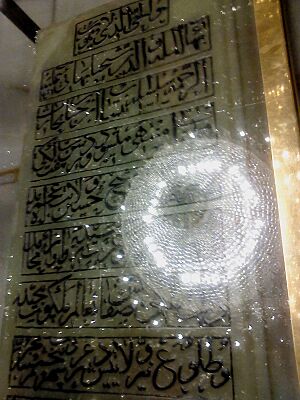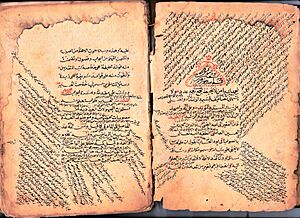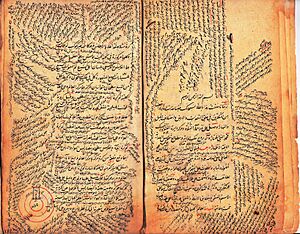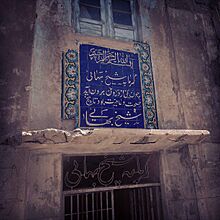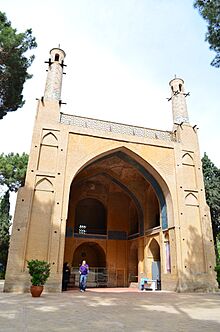Baha al-Din al-Amili facts for kids
Quick facts for kids
Baha al-Din al-Amili
|
|
|---|---|
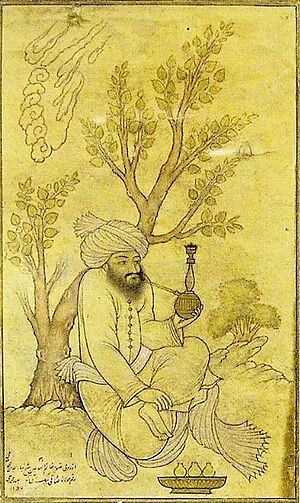
18th century copy of a miniature depicting Sheikh Baha'i, falsely attributed to Sadiqi Beg. This drawing is presumably a copy of a lost original by Sadiqi Beg
|
|
| Born | 18 February 1547 |
| Died | 1 September 1621 (aged 74) |
| Nationality | Safavid[1] Iranian [2] |
| Other names | Sheikh‐i Bahāʾī, Shaykh‐i Bahāʾī, Bahāddīn Āmilī |
| Academic background | |
| Influences | Nimatullah Wali |
| Academic work | |
| School or tradition | Isfahan School |
| Main interests | Mathematics, Architecture, Astronomy, Philosophy and Poetry |
| Notable works | Tashrīḥ Al-Aflāk, Al-Khashkūl, Nān wa ḥalwā |
| Influenced | Haydar Amuli, Mir Damad, Mulla Sadra, Mohsen Fayz Kashani |
Baha al-Din Muhammad ibn Husayn al-Amili (Arabic: بهاء الدين محمد بن حسين العاملي, romanized: Bahāʾ al‐Dīn Muḥammad bin Ḥuṣayn al‐ʿĀmilī), born on February 18, 1547, and passing away on September 1, 1621, was a super smart person from the Middle East. People also called him Sheikh Bahāʾi.
He was a scholar, poet, philosopher, architect, mathematician, and astronomer. He lived in Safavid Iran during the late 1500s and early 1600s. He was born in Baalbek, which is now in Lebanon.
When he was a child, his family moved to Safavid Iran. Sheikh Bahāʾi was one of the first astronomers in the Islamic world to think that the Earth might move. This was even before many people knew about Copernican theory. He also helped start the Isfahan School of Islamic Philosophy. Later, he taught famous thinkers like Mulla Sadra.
He wrote over 100 books and papers in Arabic and Persian. Some amazing buildings and engineering projects are said to be his ideas. These might include the Naqsh-e Jahan Square in Isfahan. He is buried in the Imam Reza shrine in Mashad, Iran.
Contents
Who Was Sheikh Bahāʾi?
Sheikh Baha' al-Din Muhammad ibn Husayn al-'Amili was born in 1547 near Baalbek, in what is now Lebanon. His family moved to Iran when he was young. This was after a sad event where his father's teacher was executed in 1558.
They first moved to Isfahan, then to Qazvin, which was the capital city of Iran at that time. The king, Tahmasp I, was ruling Iran. He asked Sheikh Bahāʾi's father to be a religious leader in important cities. This helped spread Twelver Shi'ism among the people.
Sheikh Bahāʾi finished his studies in Isfahan. In 1570, he traveled to many Islamic countries like Iraq, Syria, and Egypt. He spent four years exploring before returning to Iran.
He passed away in 1621 in Isfahan. His wish was to be buried in Mashhad, and so he was.
Birth and Death Dates
It's interesting that the exact dates of his birth and death are slightly different. You can find one set of dates on his grave stone. Another set is on the ceramic tiles on the walls of his burial room.
The dates on the wall are more detailed. They include the day, month, and year. The dates on the grave stone only show the month and year. The ceramic tiles were made in 1945. It seems that at that time, researchers looked into his exact dates. This is why the day was added to the dates on the wall.
His Pen Name
Sheikh Baha' al-Din chose the pen name 'Baha'. A pen name is a special name writers use. He was inspired by words from important religious leaders. These leaders said that a special name of God was found in certain prayers. The name "Bahá" appears four times in one of these prayers.
Smart in Science: Astronomy and Math
Sheikh Bahāʾi was very interested in science. He wrote many books and papers about it. He wrote about 17 works on astronomy and related topics.
Here are some of his important works:
- Risālah dar ḥall‐i ishkāl‐i ʿuṭārid wa qamar: This book tried to fix problems in the old Ptolemaic system of how planets move.
- Tashrīḥ al‐aflāk (Anatomy of the celestial spheres): In this book, he said that the Earth might actually be moving! He was one of the first Islamic astronomers in the 1500s to suggest this. He thought of this idea on his own, not because of ideas from Europe.
- Kholasat al-Hesab (The Summa of arithmetic): This was a popular math textbook. It was even translated into German in 1843.
Amazing Architecture
Sheikh Baha' al-Din was also a master of mathematics, architecture, and geometry. Many building designs are said to be his work. However, it's hard to find old papers that prove he designed them all.
He is often given credit for planning the city of Isfahan during the Safavid time. People say he designed Imam Square and the Imam Mosque. He also made a special sun clock on the west side of the Imam Mosque.
He was also great at planning how land is used. For example, he directed the water from the Zayandeh River to different parts of Isfahan. He designed a canal called the Zarrin Kamar. This is one of Iran's biggest canals. He also figured out the direction of Qiblah (the direction Muslims pray towards) from the Imam Square.
He also designed a special furnace for a public bathhouse. This bathhouse, called Sheikh Bahai's Bathhouse, is still in Isfahan today. People say the furnace was heated by just one candle! This candle was placed in a special closed area and burned for a very long time, keeping the bath water hot. It's said that if the area was opened, the candle would go out. When the building was being fixed, the area was opened, and the system stopped working.
Actually, Sheikh Bahāʾi likely used natural flammable gases. These gases came from a nearby cesspool (a pit for waste). In the late 1960s, workers found underground pipes made of clay. These pipes probably guided the gas to heat the bath water. This shows he might have known about biogas!
Some people also say he designed the Manar Jonban (Shaking Minarets) in Isfahan. But this building was actually built much earlier, in the 1300s.
Because of his amazing work, Iran celebrates April 23 as National Architect Day. This day marks his birthday.
Religious Knowledge
In the Twelver tradition (a branch of Islam), Sheikh Bahāʾi is seen as a very important scholar. He was so smart that Shah Abbas, the king, admired him greatly. The king made him the Sheikh ul-Islam of Isfahan. This was a very high religious position.
He wrote many works on religious topics. These included explanations of the Qur'an (tafsir), sayings of the Prophet (hadith), and Islamic law (fiqh).
Mystical Side
Sheikh Baha' al-Din was also interested in mysticism, which is a spiritual path. He had a strong connection to Sufi ideas. Sufism is a mystical branch of Islam. When he traveled, he sometimes dressed like a Dervish (a Sufi follower) and spent time with Sufi groups.
He believed that Sufis were true believers. He also wrote that people should look at their ideas fairly. He even shared some of his own mystical experiences. His poems, both in Persian and Arabic, are full of mystical ideas and symbols. However, Sheikh Baha' al-Din also believed that people should strictly follow Islamic law. He thought this was important before exploring deeper spiritual paths.
His Writings
Sheikh Baha' al-Din wrote many works on philosophy, logic, astronomy, and mathematics. He wrote over 100 articles, letters, and books. He also wrote poems in Persian and Arabic.
Some of his famous Persian works include:
- Jāmi’-i Abbāsī
- Two long poems called Shīr u Shakar ("Milk and Sugar") and Nān u Halwā ("Bread and Halva").
Another important work is the Kashkūl. This book is a collection of stories, news, scientific facts, and proverbs in both Persian and Arabic.
He also wrote Khulāṣat al‐ḥisāb (Arabic: خلاصة الحساب, meaning "Essentials of arithmetic"). This was an Arabic textbook that was very popular across the Islamic world for a long time. It was translated into German in 1843 and into French in 1854.
Other Works
- Meklāt (in Arabic)
- Kashkūl (in Persian and Arabic) (کشکول)
- Tūtī-Nāmah (in Persian) (طوطی نامه)
- Nān u Panīr (in Persian) (نان و پنیر)
- Shīr u Shakar (in Persian) (شیر و شکر)
- Nān u Halwā (in Persian and Arabic) (نان و حلوا)
- Jāmi'-i Abbāsī (in Persian) (جامع عباسی)
- Tashrīḥ Al-Aflāk (in Arabic) (تشريح الأفلاك)
- Al-fawayid as-Samadiah (in Arabic)
- Mashriq al-Shamsayn wa Iksīr al-Sa'adatayn (in Arabic) (مشرق الشمسين وإكسير السعادتين)
- Al-Athnā' Ash'ariyyah (in Arabic) (الأثناء عشرية)
- Zubdat al-Usūl (in Arabic) (زبدة الأصول)
See also
- Sheikhbahaee University in Isfahan, which is named after him.


